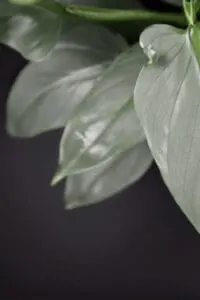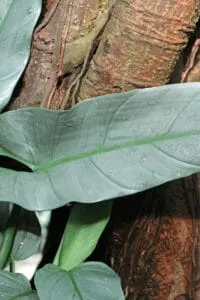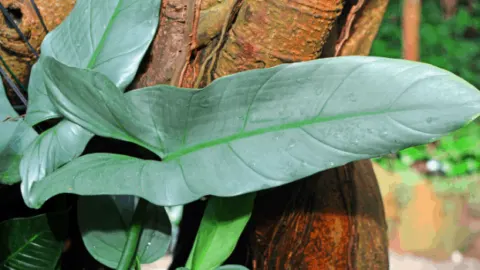Have you ever googled how to take care of the Silver Sword Philodendron and had no luck in finding a complete care guide?
Well, search no more. You have found the perfect one.
The Silver Sword Philodendron or Philodendron hastatum by its botanical name is a wonderful-looking plant that is much underrated.
Here are our basic care tips for Philodendron Hastatum Silver Sword.
Silver Sword Philodendron Care
To care for the Silver Sword Philodendron use well-draining soil with peat and perlite. Let the top 1-2” of soil (2.5-5cm) dry out between watering. The temperature should be between 65° and 80°F (18-27°C). The humidity should be >50%. Fertilize once a month using a balanced fertilizer in the growing season.

Silver Sword Philodendron Care
Table of Contents
Silver Sword Philodendron Care Guide
The Silver Sword Philodendron is ordinarily not a tough cookie regarding maintenance, this being the reason why it is so popular in the category of house plants.
Some say it is harder to find them, as they are quite rare than to take care of them.
Soil
The Silver Sword Philodendron prefers loose and well-draining soil, where water can easily percolate.
I use peat and perlite to loosen up regular potting soil to create well-draining soil.
It likes moisture and soil with high organic matter, but it doesn’t want its roots to be soaking wet because as a result, you may face rotten roots.
Light
Many Philodendrons, including the Silver Sword Philodendron, enjoy bright indirect light.
They are not fond of direct sunlight so be cautious it does not touch the leaves of your plant friend as it can burn them quickly.
If you grow Silver Sword Philodendron outside, the best solution would be to find a partly shaded spot, 70 to 85% sunlight, close to a window.
Given the glossy foliage, the Silver Sword Philodendron can cope with lower light conditions, but this is not ideal.
Now and then, it is common for the older leaves to become yellow but if this happens to several leaves it is a clear indication of too much light exposure.
On the other hand, a sign of low light exposure is a leggy stem.
I know some people prefer their plants to look sparser and with smaller leaves, but if you choose a spot with perfect lighting, your Hastatum’s foliage will grow thicker and closer together so it looks full and healthy.
Watering
Silver Sword Philodendron water about once a week during the summer and spring months. Make sure the top 1-2 inches of soil (2.5-5cm) is dry before you re-water the Silver Sword.
When the growth decreases in autumn and winter you might need to water less frequently.
The watering depends very much on your own conditions so see these tips as a general rule of thumb.
Your temperature, the soil itself, the humidity, and also the light your plant gets will determine how much it has to be watered.
An additional piece of advice – try to wipe or clean the leaves of your Hastatum. Maybe even rinse with water to keep them squeaky clean.
Temperature
The optimal temperature range for the Silver Sword Philodendron is between 65° and 80°F (18-27°C) during the day and around 60° (16° C) at night.
Originating from the rainforests in Brazil and some parts of Rio de Janeiro, the Philodendron Hastatum is a tropical plant and is used to warm conditions.
It can grow well in some parts of Australia, too.
Thus, I advise you to take it inside during the colder seasons to prevent it from dying in the frost if you grow it outside.
Humidity
A humidity >50% is best for the Silver Sword Philodendron.
As we are talking about a plant native to rain forests, we can confidently state it likes a humid environment, and you should try to keep humidity levels in the average area, even increase it artificially, if your home is extremely dry.
An indication of a dry atmosphere is yellow and droopy leaves and this shows you it is time to install a humidifier.

Silver Sword Philodendron prefers high humidity above 50% prefers
Fertilizer
Feed your Silver Sword Philodendron once a month with a balanced fertilizer such as NPK 10-10-10 or 5-5-5 in the growing season.
Proper fertilization will show on the houseplant – it will grow fast and produce bigger and healthier foliage.
In spring and summer, fertilizing should be done monthly to encourage healthy growth, and once in 6 to 8 weeks in fall and winter.
Also, avoid low-cost fertilizers, as they can oversaturate the soil with too much salt and destroy the plant.
The general rule of thumb is to err on the side of caution when applying fertilizer.
Under-fertilizing does usually not do all too much harm, while over-fertilizing might result in the death of your lovely Philodendron Hastatum.
Propagation
You can propagate a Silver Sword Philodendron through stem cuttings.
These stem cuttings can either be propagated in water or directly in the soil.
It is crucial to wear gloves and wash your hands after getting the job done as the Silver Sword contains toxic components according to Lancaster University so you need to make sure you don’t touch the surface directly.
Growth
The Silver Sword Philodendron is a medium to fast grower growing up to 10 feet tall (3 meters).
Personally, I would characterize the growth of the Silver Sword as a medium to large and quite fast, given they can grow up to 10 feet (3 meters) in height and 5 feet (1.5 meters) in width and they are able to create a new leaf each month.
That’s pretty fast if you ask me.
Some wild Hastatums are even capable of growing twice in height.
Just remember, the looser the roots are, the taller your plant will be.
Potting
Repot Silver Sword Philodendron once the roots filled up the pot using a new pot with a 1-2” (2.5-5cm) larger diameter.
When I touch on potting, the fundamental thing is to acquire a pot that has drainage holes to prevent the soil from becoming too wet and moist. Just tend to this matter and you are all set to go.
Additionally, round pots have proven to be the most desirable for Hastatums.
Also, It is possible to place your Silver Sword in a hanging basket.
If you are asking yourself when is the time to re-pot, the answer is, well, when the roots fill out the bottom of the old pot purchase a new and bigger plant pot.

Silver Sword Philodendron are climbers
Silver Sword Philodendron – The Plant
Its nickname, the Silver Sword Philodendron, derives from its amazing silvery-blue, almost mirror-like foliage that leaves you breathless.
Due to its arrow/sword-shaped glossy leaves, it has a marvelous appearance.
As the plant grows and matures, the leaves become more arrow-shaped, even triangular, and can reach one meter in height.
This vining Philodendron Hastatum has a thick stem structure and has a climbing growth habit, so if you desire your friend to grow in an attractive formation, get a coco pole, a trellis, or a moss poll so it can reach its full potential.
If you fail to do so, your Philodendron can grow straggly and drooping and certainly not graceful.
Propagating Silver Sword Philodendron
Step by Step
Philodendron Hastatum is quite easy to propagate.
All you need to have are some gloves and clean and sharp tools, in this case, gardening scissors.
Cut off a segment of the stem including one or a few nodes and a couple of leaves. A node is the thicker bump or place where the roots are forming. They are easy to spot.
Place the stem cutting in water and wait for several weeks, even a month and you will see roots slowly forming.
The water where your baby Hastatum is living needs to be changed regularly to make it comfortable for healthy growth.
Keep an eye on the sunlight, too.
The next step is to pot it nicely with nutritionally rich soil and water by instruction in the very moment you notice the roots are at least a few inches long.
In the following weeks, your baby is going to grow its first new leaves.
After that, take care of it and you have a new member of your plant family, or you can bring it as a gift for a fellow plant-lover.
Common Problems with the Silver Sword Philodendron
Like every plant, the Silver Sword comes along with some issues.
Philodendron Hastatum Plant Pests
It is quite resilient to diseases and pests, however, in some environments that do not suit it, the Silver Sword can be attacked by spider mites and mealybugs.
You can wipe off mealybugs with cotton balls dipped in rubbing alcohol.
Periodically showering the plant with water and applying insecticidal soap will help keep pests away.
Another species that often attack the Hastatums are Red Spider Mites, tiny pests, not so easy to notice but they are spread throughout the whole world.
One hint you can look for is little cobwebs forming on the leaves.
Another type of pests that commonly attack houseplants are thrips, also tiny insects that “travel” together, in groups, and are attracted to lighter colored leaves so they may give you a nip if you are wearing light clothing.
Discoloration of Foliage
Another matter we need to discuss in this guide is the discoloration of foliage.
According to Clemson University browning or yellow leaves may indicate too much or overwatering too much sunlight, and a pot is oversaturated by fertilizer.
Remember the Hastatums are toxic and should be strictly kept away from animals and children, and you should always have your gardening gloves on before you touch the Silver Sword.
Tips to keep the Silver Sword Philodendron
problem-free
The Philodendron Hastatum is pretty easy to handle, a low-maintenance plant friend.
If you succeed in finding the perfect sport regarding sunlight, it is going to be more than thankful and give your eyes the everyday pleasure of looking at its glamorous, powerful appearance.
You need to water it regularly making sure that the first three inches of soil are dry, to avoid over-moisturizing, and make sure to re-pot it if it starts filling up the base of the pot quickly.
Remember to buy fast-draining soil to avoid the plant standing in water and make sure it is full of rich and healthy nutritional elements.
Your Silver Sword is not going to cope well with the cold so if it is outside, bring it in during the colder season. After all, it is a plant of tropical origin.
Being tropical, it likes humidity so if your environment is particularly dry, obtain a humidifier if you wish the best life for your plant friend.
That’s it!
Frequently Asked Questions About Silver Sword Philodendron Care
How big does a Philodendron Hastatum get?
It can grow up to 2 meters in height if it is normal-sized and some can even exceed and grow up to 3 meters.
How often do I need to water it?
If you see that the top 2 or 3 inches of soil are dry, stop thinking about it and water your friend.
When is the time to re-pot?
Simply, when you see that its roots are becoming too strong and big for the current pot, switch to a bigger one.
Conclusion About Silver Sword Philodendron
The Silver Sword Philodendron is usually admired for its unique and marvelous foliage color.
It is quite rare to see metallic-looking leaves, leaves that are sometimes blue and sometimes gray, and in the shape of an arrow or a heart.
The climbing habit it has makes it perfect for your design, meaning you can put a pole or a climbing wall and picture how that part of your house or apartment is going to look like after the Hastatum fills it up.
One fact that makes it more difficult to handle the Silver Sword Philodendron is the toxicity.
Maybe think twice about acquiring the Hastatum if you have younger children or many pet friends.
On the other hand, if not, this is going to make a fine addition to your décor. And as a bonus, you receive an air purifier.
I hope this guide has been helpful for you and if you are a true plant lover, I recommend other great care guides such as the one we crafted for Philodendron Billietiae and many other Philodendrons, whose appearance just wows you at first sight.

Daniel has been a plant enthusiast for over 20 years. He owns hundreds of houseplants and prepares for the chili growing seasons yearly with great anticipation. His favorite plants are plant species in the Araceae family, such as Monstera, Philodendron, and Anthurium. He also loves gardening and is growing hot peppers, tomatoes, and many more vegetables.


